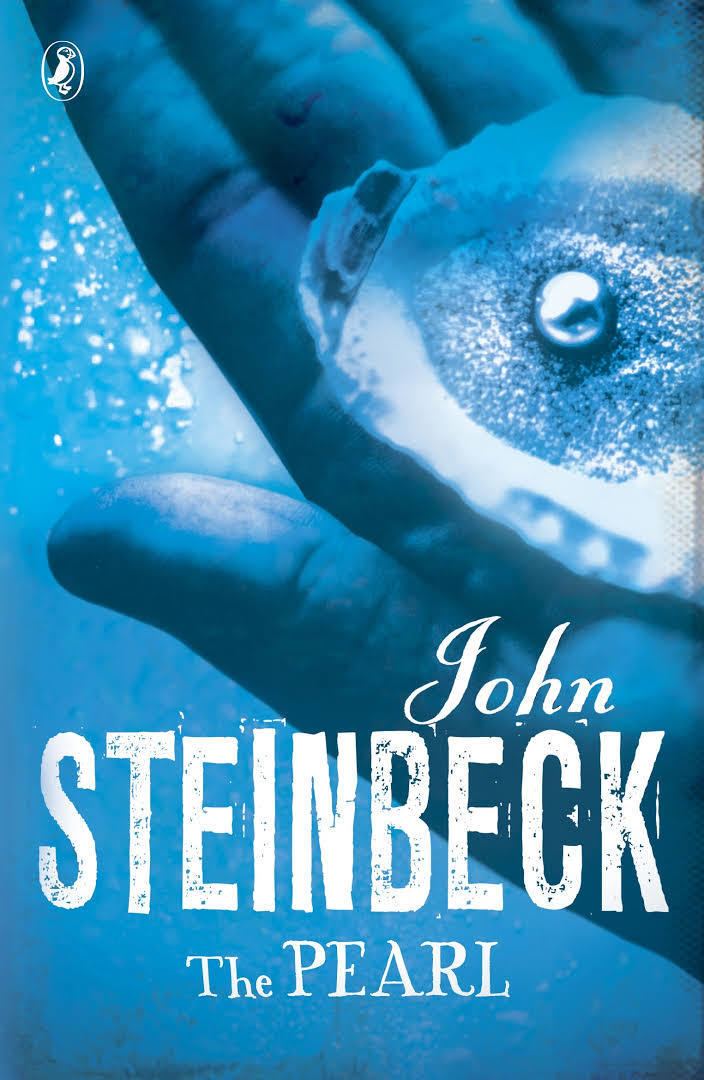Illustrator José Clemente Orozco Publication date 1947 Originally published 1947 Country United States of America | Language English, Spanish ISBN 0-14-017737-X Genres Novella, Fiction | |
 | ||
Cover artist Cover Design: Micheal Ian Kaye, Artist: Ross Mcdonald Media type Print (Hardback & Paperback) Publishers Viking Press (US), Heinemann (UK), Fondo de Cultura Económica (Mexico and rest of Latin America) Adaptations The Pearl (1947), The Pearl (2001), Ondu Muttina Kathe (1987) Similar Works by John Steinbeck, Classical Studies books, Fiction books | ||
The Pearl is a novella by American author John Steinbeck, first published in 1947. It is the story of a pearl diver, Kino, and explores man's nature as well as greed, defiance of societal norms, and evil. Steinbeck's inspiration was a Mexican folk tale from La Paz, Baja California Sur, Mexico, which he had heard in a visit to the formerly pearl-rich region in 1940. In 1947, it was adapted into a Mexican film named La perla and in 1987 into a Kannada movie Ondu Muttina Kathe. The story is one of Steinbeck's most popular books and has been widely used in high school classes. The Pearl is sometimes considered a parable.
Contents
Summary
When Coyotito, an infant, is stung by a scorpion, Kino, his father, must find a way to pay the town doctor to treat him. The doctor denies Kino, an indigenous fisherman, out of racism, which enrages him. Shortly thereafter, Kino discovers an enormous, lucid pearl which he is ready to sell to pay the doctor. Everyone calls it "the Pearl of the World," and many people begin to covet it. That very night Kino is attacked in his own home. Determined to get rid of the pearl, the following morning he takes it to the pearl auction in town; however, the auction is actually a corrupt sham and always has been. The buyers normally fake auction each pearl and pretend bid against each other, but in reality they are all paid a salary by a single man, they all turn the pearls over to him and he resells them outside the village, thus cheating the locals. The corrupt pearl buyers try to convince Kino that the pearl is the equivalent of "fools gold" and they refuse to pay any more than incredibly low amounts of money. Kino decides to go over the mountains to the capital to find a better price. Juana, Kino's wife, sees that the pearl brings darkness and greed, and sneaks out of the house late at night to throw it back into the ocean. When Kino catches her, he furiously attacks her and leaves her on the beach.
While returning to his hut with the pearl, Kino is attacked by another man whom Kino stabs and kills. Kino thinks the man has taken the pearl, but Juana shows him that she has it in her possession. When they go back to their hut, they find it has been set on fire. The family's canoe had also been ruined, an act that enrages Kino. Kino and Juana then spend the day hiding in the hut of Kino's brother Juan Tomás and his wife, gathering provisions for their trip to the capital city. Kino, Juana, and Coyotito leave in the dark of the night. After a brief rest in the morning, Kino spots trackers that he believes are following them. Well aware that they will be unable to hide from the trackers, they begin hiking into the mountains. They find a cave near a natural water hole where the exhausted family hides and waits for the trackers to catch up to them. Kino realizes they must kill the trackers if they are to survive the trip to the capital. As he prepares to attack, the men hear a cry like a baby's, though they decide it's more like a coyote with a litter. The tracker decides to fire in the direction of the sound, but just before, Kino knocks him off his balance. He proceeds to kill all three trackers, but as he travels back up to the cave, he finds that the misfire he caused when he attacked the tracker caused him to shoot Coyotito in the head. In the morning, Kino and Juana return to La Paz with Coyotito's dead body wrapped in a sling. No longer wanting the pearl, Kino throws the pearl back into the ocean.
Setting
Steinbeck began writing the story as a movie script in 1944, and first published it as a short story called "The Pearl of the World" in Woman's Home Companion in December 1945. The original publication is also sometimes listed as "The Pearl of La Paz". He expanded it to novella length and published it under the name The Pearl by Viking Press in 1947. As he was writing the novella version, he was frequently travelling to Mexico where the film version, co-written with Jack Wagner, was being filmed. The film was also released by RKO in 1947 as a co-promotion with the book.
The Pearl was loosely adapted in 2001 for a film directed by Alfredo Zacharias and starring Lukas Haas and Richard Harris which was released directly to video in 2005.
Reception and analysis
The book received initial positive response from publications such as The New York Times and Library Journal.
The story is one of Steinbeck's most popular books and has been widely used in high school and middle school classes.
Jackson Benson writes that The Pearl was heavily influenced by Steinbeck's interest in the philosophy of Carl Jung. Steinbeck wrote that he created the story of The Pearl to address the themes of "human greed, materialism, and the inherent worth of a thing."
The Fleming & John song "The Pearl" was based on this story.
The American composer Andrew Boysen's Concerto for Trombone and Wind Symphony (2004) was inspired by The Pearl.
